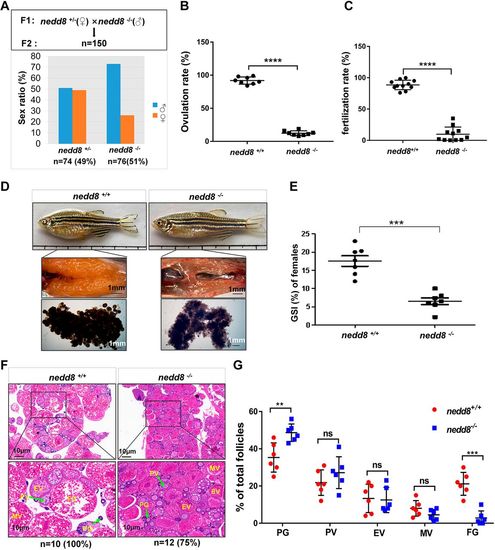
Loss of nedd8 in zebrafish causes defects in ovarian maturation and reduces female ratio, ovulation rate and fertilization rate. (A) The sex ratios of nedd8+/− and nedd8−/− progeny generated by nedd8+/− (♀)×nedd8−/− (♂) matings. Histograms show percentages of females and males in 150 crossbreed offspring. (B) The ovulation rates (n=8; number of spawned females/the total number of females tested×100) of the nedd8+/+ and nedd8−/− female zebrafish mated with nedd8+/+ male zebrafish (n=11). (C) The fertilization rates of nedd8+/+ and nedd8−/− eggs. The fertilization rates were determined by mating nedd8+/+ and nedd8−/− female zebrafish with nedd8+/+ male zebrafish. (D) Bodies, ovaries and dissected eggs from a nedd8-null female zebrafish (nedd8−/−) and her wild-type sibling (nedd8+/+) at 4 mpf. Images show the elongated body, transparent ovaries and degenerated eggs of the nedd8−/− adult female, and the rounded body, egg-filled ovaries and mature eggs of the nedd8+/+ adult female. (E) The GSI of the nedd8+/+ and nedd8−/− females at 4 mpf (n=7). (F) H&E staining of the ovaries of wild-type zebrafish (nedd8+/+) (n=10; 100%) and nedd8-knockout zebrafish (nedd8−/−) (n=12; 75%) at 4 mpf. (G) The percentage of oocytes at different stages of development in wild-type zebrafish (nedd8+/+) and nedd8-null zebrafish (nedd8−/−) at 4 mpf (three sections/fish; six fish/genotype). Each dot represents average number of oocytes in one section. PG, primary growth stage; PV, previtellogenic stage (7-140 μm in diameter); EV, early vitellogenic stage (140-340 μm in diameter); MV, midvitellogenic stage (340-369 μm in diameter); FG, full-grown stage (0.69-0.70 mm in diameter). Data are mean±s.e.m. **P<0.01, ***P<0.001, ****P<0.0001 (one way ANOVA test). ns, not significant.
|

